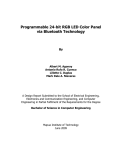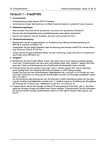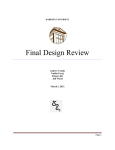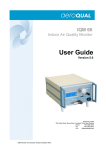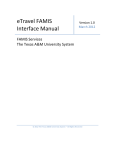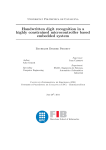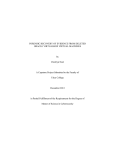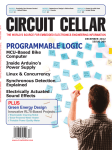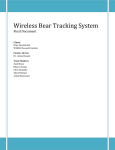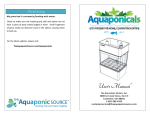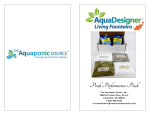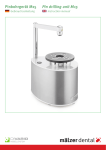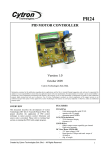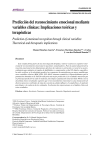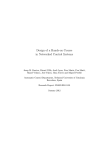Download Final Research Paper - Union College Blogging
Transcript
ECE 498
Senior Project
Spring 2014-Winter 2015
Automated Aquaponics
Design Report
By
Carson Miller
*********
Submitted in partial fulfillment
of the requirements for
Honors in the Department of Electrical Engineering
UNION COLLEGE
June, 2015
i
ECE 498
Senior Project
Spring 2014-Winter 2015
ABSTRACT
“Aquaponics is the cultivation of fish and plants together in a constructed, recirculating
ecosystem utilizing natural bacterial cycles to convert fish waste to plant nutrients” [1].
Aquaponic systems offer a solution to environmentally conscious, fiscally responsible
individuals who wish to produce food products without the use of pesticides, genetic
modification, or non-renewable resources. Further, the proliferation of inexpensive
microprocessors and high quality sensors offers an opportunity for dynamic monitoring and error
correcting within the aquaponic system. These aquaponic and electronic systems will be
combined in this project to create an electronically monitored aquaponic ecosystem.
ii
ECE 498
Senior Project
Spring 2014-Winter 2015
TABLE OF CONTENTS
ABSTRACT.................................................................................................................................................. ii
TABLE OF FIGURES AND TABLES ....................................................................................................... iv
INTRODUCTION ........................................................................................................................................ 1
BACKGROUND .......................................................................................................................................... 2
ORIGINALLY PROPOSED DESIGN REQUIREMENTS ......................................................................... 4
ORIGINALLY PROPOSED ELECTRONIC DESIGN REQUIREMENTS ............................................... 6
FINAL DESIGN REQUIREMENTS ........................................................................................................... 8
DESIGN ALTERNATIVES ......................................................................................................................... 9
PRELIMENARY PROPOSED DESIGN ................................................................................................... 11
FINAL DESIGN AND IMPLEMENTATION ........................................................................................... 13
PERFORMANCE ESTIMATES AND RESULTS .................................................................................... 17
PRODUCTION SCHEDULE ..................................................................................................................... 18
COST ANALYSIS...................................................................................................................................... 20
USER’S MANUAL .................................................................................................................................... 21
Construction ............................................................................................................................................ 21
Operation ................................................................................................................................................ 22
DISCUSSION, CONCLUSIONS, AND RECOMMENDATIONS ........................................................... 22
REFERENCES ........................................................................................................................................... 24
APPENDIX ................................................................................................................................................. 26
iii
ECE 498
Senior Project
Spring 2014-Winter 2015
TABLE OF FIGURES AND TABLES
TABLE 1.Originally Proposed Design Requirements…………………………………………..5
TABLE 2.Originally Proposed Electronic Design Requirements…….……………………........7
TABLE 3.Final Design Requirements…………………………..……………………………….9
TABLE 4.Electronic System Component Choices………...…………………………………….11
FIGURE 1.Originally Proposed Electronic System Block Diagram…………………….…...….13
FIGURE 2.Overall System...…………………………………………………………………….14
FIGURE 3.Grow Bed Materials…………………………………………………………………14
FIGURE 4.Goldfish………………………………………………………………………...……14
FIGURE 5.Electronic Block Diagram…………………………………………………………...15
FIGURE 6.Photosynthesis vs Wavelength………………………………………………………15
TABLE 5.Project Schedule………………………………………………………………………19
TABLE 6.Expenditures…………………………………………………………………………..20
iv
ECE 498
Senior Project
Spring 2014-Winter 2015
INTRODUCTION
As the population of the world continues to increase, so does the demand for clean water
and high yield farmland. These resources are unfortunately finite, and in especially high demand
in cities and underdeveloped areas. As time progresses, both individuals and companies will be
looking for more efficient ways to produce food for human consumption that conserve space and
water. Electronically monitored aquaponics offers the ability to produce fish and vegetative
growth for human consumption in a highly efficient, sustainable ecosystem, thus solving the
aforementioned problems. Organically filtered water leads to healthy fish and, as long as high
quality fish food and lighting systems are used, fast growing and high quality produce will result.
[1].
It was the purpose of this project to create an electronically monitored system capable of
producing vegetables and fish for consumption. In addition to operating without the production
of any waste water, the system was also designed to provide feedback and monitor the biological
components so that any serious problems were detected and displayed user interface. The
project will be considered successful when the system operates for over one month with a grow
bed full of healthy vegetables and tank full of live fish. Further, temperatures not between 40C
and 75C, grow light on times not between 10 and 16 hours, and flood cycles not between 10 and
20 minutes must be detected and displayed on the user interface while also sounding an alert
buzzer.
This report explores the design requirements for the project, as well as the final design
and alternatives that were considered during the research and construction phase of the project.
After providing a background in the field of aquaponic and electronic systems, this report will
examine the requirements that the prototype completed at the end of the project must meet to be
1
ECE 498
Senior Project
Spring 2014-Winter 2015
considered successful. Alternative designs choices that could have been read the reasoning
behind the selections that were made will also be discussed in this paper. Finally, the proposed
design will be outlined, as well as the progress that has been made thus far.
BACKGROUND
Basic, electronically monitored aquaponic systems have been built in the past by both
researchers and corporate entities. In [2], other researchers created an automated aquaponic
system. They used a glass fish tank stocked with comet goldfish to provide the aquaculture
based element of the system. The plants were grown in a lit grow bed above the fish tank, and
temperature sensors were used in conjunction with an Arduino computing platform for
monitoring and feedback. Further, they added a 4x20 LCD display to convey temperature
information to the system’s users. Their project documentation provided an excellent reference
for the future research in Aquaponics that will be performed at Union. It was our goal to expand
upon the research they performed to create a better electronic system capable of thoroughly
monitoring the conditions of the aquaponic system and conveying that information to the user for
action if necessary. Differences between the research performed by [2] and the research
performed at Union include the addition of temperature and light sensors, water level sensors,
indication diodes, pushbutton interfaces, and, eventually, the breeding of edible fish. Further, the
Arduino computing platform was not be used in favor of a less expensive microcontroller that
still performs all desired system functions [3].
With respect to manufacturability, there were commercially available electronically
controlled and monitored aquaponic systems and components. These systems, available from the
Kijani Grows company, used the Arduino computing platform and were avaliable in various
configurations [4]. The price of complete, commercially available and electronically monitored
2
ECE 498
Senior Project
Spring 2014-Winter 2015
aquaponic systems ranged from $999 to $1524. Additionally, the aquaponic system platform,
without any electronics included, was available for between $500 and $949. Further, various
electronic parts were available for purchase with the entire electrical system available for $495$690, the sensor package available for $205, and their Arduino shield available for $25-$55. The
fish tank size of Kijani Grows’ aquaponic systems ranges from 75 to 150 gallons and specific
productions yields for each system are not specified. These products were different from the
system that was built at Union because they use the Arduino computing platform and did not
offer the sensing and interface technologies that were implemented at Union [4].
Agricultural production within New York State is overseen and regulated by the New
York State Department of Agriculture and Markets. The Department of Agriculture and Markets
does not consider roadside stands, on-farm outlets, or farmers markets to be, “retail food stores”
and thus, these bodies are not required to meet the strict standards to which retail food
production and processing bodies must abide. Since permits are not required for the production
or sale of vegetables, government bodies did not need to be contacted for the vegetable
production aspect of this project [5]. Additionally, since the goldfish were kept in a, “closed
loop, recirculating system,” a permit was not required for the aquaculture based portion of the
project either [6]. If a commercial venture were to be undertaken, the appropriate permits must
be obtained from the New York State Department of Agriculture and Markets and, depending on
the fish being produced, the New York State Department of Environmental Conservation [5] [7].
Overall, aquaponics offers great commercial, economic, and environmental opportunities.
Economically, aquaponics is feasible because it harnesses several relationships that exist in
nature. As a result of these special relationships that exist between the fish, bacteria, and plants,
hardware is no longer required for water filtration, and nutritional supplements are no longer
3
ECE 498
Senior Project
Spring 2014-Winter 2015
necessary as they would be in a hydroponic system [1]. In aquaponics the plants take care of the
water filtration and the fish provide the nutrients. Further, as long as high quality, nutritious and
organic fish food is used in the system, the consumable fish and vegetation will be natural and
organic. The combination of such a highly efficient system with the premium, organic nature of
the consumable output makes for an excellent economic opportunity for individuals and
businesses alike.
In addition to being a great commercial and economic opportunity, automated aquaponics
is also great for the environment, as it mirrors and develops relationships in ecosystems that
occur naturally in the wild [1]. Aquaponic systems are highly efficient with water because the
only water that leaves the system is lost due to evaporation. When a system is built outdoors or
in a greenhouse that allows sunlight, systems become even more efficient by utilizing freely
available light for plant growth. Furthermore, since, with the help of beneficial bacteria, the
vegetables are filtering the water extraordinarily well, fish can be more heavily stocked and bred
without interfering with their health. Similarly, the vegetables can be planted closer together
than in a traditional garden because the competition for nutrients between plants is minimal.
Competition is low because the abundant fish waste is continuously being converted to nutrients
and introduced into the water all around the grow bed [1].
ORIGINALLY PROPOSED DESIGN REQUIREMENTS
Sylvia Bernstein, a trusted source among aquaponic hobbyists, wrote Aquaponic
Gardening in 2011 to document effective methods to create and maintain an optimal aquaponic
ecosystem. [8] [1]. Her work provided the foundation of knowledge used to design and build the
biological components of this project including the grow bed, fish tank, and water circulation
system. The originally proposed design requirements, listed below in Table 1, were generated by
4
ECE 498
Senior Project
Spring 2014-Winter 2015
combining the recommended system design from Bernstein’s guide with the desires of our end
user.
The system must output sufficient light from LEDs to maintain plants
Growth
Optimization
The system must be able to provide 200 total gallons for aquaculture and
hydroponics (Divided 1:1) [1]
The Tilapia must actively breed and maintain their population independently
The water level must only decrease due to evaporation
The system water level must not decrease beyond 15% of the tank capacity
The fish feeding mechanism must output feed between 1% and 1.5% of the total
fish weight [9]
System
Specifications The pH stay at a level between 6 and 9 [9]
The temperature must be maintained at a level between 79°F and 87°F if tilapia
are kept [9]
The LEDs must indicate whether system maintenance is required
User Alert
The LCD display must display all measured data in real time
Table 1.Originally Proposed Design Requirements
The system overview included above was created to satisfy the requirements listed above
in Table 1. As seen in the table, the design requirements are divided into three distinct groups.
The design requirements under the ‘growth optimization’ heading were created to ensure the
healthy growth of the fish and plants within the system. Additionally, these requirements, such
as the Tilapia breeding requirement, were created to ensure that the system is self-sustaining and
providing a substantial amount of edible output.
5
ECE 498
Senior Project
Spring 2014-Winter 2015
The ‘system specifications’ related design requirements were created to ensure that the
system operates optimally. These specifications were used to define when the user interface
should alert the system manager to any potential problems. Finally, the ‘user alert’ related
design requirements were created to ensure that system users were alerted to potential problems
through the appropriate user interface medium. These requirements were defined by customer
desires.
After combining the instructions offered in Bernstein’s book with the design goals for
this project, the materials list for this project was generated. Since Tilapia will be cultivated, and
a significant amount of food must be produced by the system, Rubbermaid’s 100 gallon stock
tank was used as the fish tank [10]. As specified in Bernstein’s guide, a 1:1 fish tank capacity to
grow bed size was used. Due to the unavailability of inexpensive grow bed tables, it will be
easiest to fabricate a custom table to the exact specifications desired. Connecting the grow bed
table and the fish tank will be a system of PVC piping, as well as a pump and pump triggering
mechanism. These components constitute the biological system [1].
ORIGINALLY PROPOSED ELECTRONIC DESIGN REQUIREMENTS
The originally proposed electronic system design requirements are included below in
Table 2. Most of these requirements were actually consequences of design choices that were
made and therefore not a suitable means by which the final system could be evaluated. For this
reason, and due to changes resulting from the evaluation of the system as the project progressed,
the design requirements were later rewritten and are included below. For the sake of
completeness, the original design requirements in Table 1 above and Table 2 below were
preserved.
6
ECE 498
Senior Project
Spring 2014-Winter 2015
The system (excluding off the shelf components) must operate on +5V
The PIC must communicate with the user interface using an I2C bus
The various sensors will be read using the digital or analog (when appropriate)
channels of the PIC
Specific
Electronic
Design
Power must be supplied to all components (excluding off the shelf components)
Requirements using an AC to DC converter capable of supplying the appropriate current.
The system must have a ‘sleep mode’ capability in which the user interface and
PIC move into a low power mode. This low power mode will be interrupted if
the timer indicates action is required or if a button on the user interface is
pushed.
Table 2.Originally Proposed Electronic Design Requirements
Table 2 above shows the originally proposed electronic system design requirements for
the project. In order to allow for the simple addition of peripheral components in the future, an
I2C bus was implemented. Currently, this I2C bus only handles the communication between the
PIC and the user interface display. The data displayed on that user interface comes from sensor
information read in using the analog input channels on the PIC as well as the serial port not being
used for I2C. Additionally, the ability for the microcontroller to go into a sleep mode for power
saving was listed.
In addition to the electronic monitoring system, the lighting system was also designed
specifically for this project. The lighting was designed to incorporate the appropriate amount of
blue and red light to optimize plant root growth, leaf development, and flowering [11]. Three
watt LEDs were selected because, with the appropriate heat sink and drive circuitry, they provide
7
ECE 498
Senior Project
Spring 2014-Winter 2015
maximal light output while creating a manageable amount of heat. Further, the drive circuitry
was created to interface with the 12V DC power supply and output a constant current into the
LEDs. Eventually, for research purposes, dimming capabilities and the ability to turn off either
color will be added to the system based on an interest from corporate aquaponics farmers [12].
FINAL DESIGN REQUIREMENTS
Since the original design requirements were vague and did not naturally lead to a valid
testing plan that could easily determine the overall success of the project, newer design
requirements were generated, and are included in Table 3 below. They are very similar to the
older requirements listed above, but instead provide numerical requirements for most of the
criteria so that the success of the project could be tested.
The biological system requirement numbers were chosen as a parameter by which the
system’s capability to sustain a substantial amount of life over a reasonable period of time could
be evaluated. The budget was determined after ascertaining the general cost of similar systems
and calculating the funding that would be necessary to create this system with aggressive cost
reductions. The sensor measurement resolution requirements were created by determining how
much resolution would be needed to accurately detect errors within the parameters being
monitored. The sleep mode requirement was added to allow for experimentation with power
reduction. Lastly, the alert triggering requirements were added so that the microcontroller could
alert users of issues before they become critical.
8
ECE 498
Senior Project
Spring 2014-Winter 2015
Biological System Requirements
Project Budget
±1℃
Sensor Measurement Requirements
Electronic Requirements
40ºC < Temperature < 75ºC
Alert Triggering
10 hrs. < Grow light on time < 16hrs.
10min. < Grow bed flood time < 20min.
Table 3.Final Design Requirements
DESIGN ALTERNATIVES
Various design choices were made when determining how to construct and evaluate the
overall system. The biological system was designed first so that the electronic monitoring
components could be specifically selected to suit the biology. The main source used for the
design of the biological system was Sylvia Bernstein’s Aquaponic Gardening because it is
widely accepted as the definitive guide to creating and maintaining a successful aquaponic
system. Further, Sylvia cited 45 references in the book, and is generally regarded as one of the
premier leaders in the global aquaponic community.
The system was designed to offer 100 gallons worth of grow bed space at 12” deep, with
a 100 gallon fish tank. This design utilized Bernstein’s widely accepted 12” grow bed depth
9
ECE 498
Senior Project
Spring 2014-Winter 2015
theory while also maintaining the 1:1 grow bed to fish tank volume ratio that she suggests for
beginner aquaponic gardeners. For the grow bed, a basic flood and drain system was selected
because it was the simplest, easiest to implement system that is commonly used among beginners
in aquaponics. If the flood and drain setup ever needs to be changed, and a constant water level
fish tank is desired, the plumbing system can always be redesigned after the project has been
completed [1].
The system hardware was also generally chosen based on Sylvia Bernstein’s
recommendations. A 100 Gallon Rubbermaid stock tank was chosen as suggested in Bernstein’s
Aquaponic Gardening. The grow bed was custom built from wood, caulk, and FRP wall board,
to keep the project within its $1,000 budget. The basic idea is to build a wooden exterior for
support with sealed FRP wall board on the inside walls of the bed to keep the water from leaking
[13]. The grow bed must be able to support the weight of the water as well as the grow bed
media within which the plants will grow. Expanded clay pebbles were chosen as the grow bed
media because they could be found at a relatively reasonable price from Organica in Albany, and
are lightweight, ph neutral, and easy to handle. The first batch of expanded clay that was
purchased floated when submerged, and had to be replaced by the manufacturer. HydroFarm
sent the superior Hydro Corn product as a replacement, which is currently installed in the
system. Lastly, goldfish were selected because they are inexpensive and create a great deal of
waste that will be converted to nutrients for the plants. Additionally, they do not require a heater
and can tolerate a wide range of conditions [1].
The electronic monitoring devices and hardware were also carefully selected to monitor
system parameters that could lead to catastrophic failure if not properly responded to in the event
of a malfunction. These parameters include grow bed water level, water temperature, LED light
10
ECE 498
Senior Project
Spring 2014-Winter 2015
levels, and room occupancy. Having decided that these parameters are critical and must be
monitored to ensure that the system does not fall into unreported critical failure, each electronic
component was selected to ensure adequate monitoring at the lowest possible cost. To that end,
the following decisions were made:
Parameter
Grow Bed Water Level
Selection
Ultrasonic Sensor
Alternatives
eTape Liquid Level Sensor – Not chosen
because it was too small & expensive [14]
Water Temperature
Temperature sensor
Couldn’t find other food safe temperature
by Atlas Scientific
sensors
LED Light Levels
Light sensor by
Couldn’t find other food safe light level
Atlas Scientific
sensors
Room Occupancy
Infrared Occupancy
Other infrared sensors were more
Sensor
expensive [15]
Table 4.Electronic System Component Choices
The sensors selected, shown above in Table 4, were chosen because they offered the least
expensive solution that was both food safe and met the minimum resolution requirement
specified in the design requirement section. The lack of options in food safe monitoring
solutions was a complication that caused difficulty in various stages of this project. Thankfully,
Atlas Scientific produces high quality, waterproof, and food grade light and temperature sensors
that can be submerged indefinitely. These sensors are used to monitor select parameters in this
project, along with a PING ultrasonic sensor which does not come in contact with the biological
components.
PRELIMENARY PROPOSED DESIGN
It was proposed that the electronic system will perform all monitoring, error correcting,
and user alert actions necessary to maintain the unit’s ecosystem. The user interface would
consist of an LCD display, pushbuttons, and LED indicators. The user interface display from
Matrix Orbital was selected because their product fit into the 5.25” bay of a PC tower [16]. The
11
ECE 498
Senior Project
Spring 2014-Winter 2015
empty PC tower was also set to be used to house other relevant electronic control equipment if
necessary. Additionally, plans for constructing a grow light made up of 3W LEDs were created.
The system’s sensors would interface with the microcontrollers while the grow lights would be
connected to the rest of the electronic system. The only system component not controlled and
monitored by the microcontroller would be the pump which, due to its line voltage and high
current requirements, was controlled safely and externally by ‘off the shelf’ products. All
initially planned major electronic subsystems being used in the project are shown, with their
connections, in Figure 1 below. These systems are explained in detail in the final design and
implementation section included below.
12
ECE 498
Senior Project
Spring 2014-Winter 2015
Figure 1.Originally Proposed Electronic System Block Diagram
FINAL DESIGN AND IMPLEMENTATION
The project was presented on February 28th, 2015 to an audience of Union College
faculty, students, and members of industry. At that time, the grow bed was filled with sixty-two
healthy heads of lettuce, the fish tank was filled with twenty-five healthy fish, and the electronic
system was monitoring the temperature and the water level of the grow bed. The user interface
was displaying temperature and water level characteristics, while the alarm was hooked up to a
switch for demonstration purposes. Further, there was an issue with the interrupt service routine,
so the software was changed to simply take measurements. Figure 2 below shows the overall
system.
13
ECE 498
Senior Project
Spring 2014-Winter 2015
Figure 2.Overall System
The biological system, at the time of the presentation, was in full working condition. The
grow bed was filled with twelve inches of expanded clay pebbles and composting worms. The
composting worms were added to help break down the solid fish waste, and to decompose dead
plant roots. The grow bed was flooded every fifteen minutes with water from the fish tank
which, with the help of beneficial bacteria and the composting worms, provided the sixty-two
heads of lettuce with an abundance of nutrients. The grow light, which provided the lettuce with
energy for photosynthesis, was also fully functional at the time of the presentation. The grow
light LEDs operated at a ratio of 16 hours of on time to 8 hours of off time. Lastly, the fish tank
was only filled with twenty-five comet goldfish due to a large number of deaths in the fish tank
that occurred over the college’s winter vacation. The cause of death was likely overfeeding as
the automatic fish feeder wasn’t properly adjusted before the vacation.
Figure 3.Grow Bed Materials
Figure 4.Goldfish
14
ECE 498
Senior Project
Spring 2014-Winter 2015
The electronic system was designed to meet the specifications discussed above with
special attention paid to ensuring that all of the electronic components and sensors that may
come into connect with the grow bed were properly sealed and food grade. The final electronic
hardware included in the system were a user interface with LCD display and push buttons,
custom grow LEDs, a temperature sensor, an ultrasonic water level sensor, a light level sensor,
and voltage conversion devices. Each of these system components can be seen abstracted into a
block diagram in Figure 5 below.
Figure 5.Electronic Block Diagram
Figure 6.Photosynthesis vs Wavelength
The wavelength of the grow LEDs was specifically chosen to maximize photosynthesis.
A graph comparing photosynthesis rate per unit wavelength is shown above in Figure 6. The
two peaks of photosynthesis were matched to wavelengths at which LEDs are commonly
manufactured. These wavelengths were a 445nm blue light and a 665nm red light. The
aforementioned light level and temperature sensors were purchased from Atlas Scientific as the
company produces food grade sensors that can be submerged and operated in liquids indefinitely
without maintenance. The water level sensor consists of a PING ultrasonic sensor from Parallax
15
ECE 498
Senior Project
Spring 2014-Winter 2015
mounted at the top of the grow bed looking down into a pipe where the water level can be seen.
The data from each of these sensors is displayed on the Matrix Orbital interface. Additionally,
the voltage conversion hardware consists of an AC/DC converter to change the line voltage to
12VDC. That 12VDC is used by the LEDs and also fed into a DC/DC voltage converter which
steps the voltage down further to 5V. The remainder of the circuit components all operate on the
5V produced by the step down converter.
As previously mentioned, the communication between the various electronic components
of this system was complicated by the unique demands of the aquaponic environment. Since all
of the sensors had to be food grade or have the ability to operate without coming into contact
with the biological system, there wasn’t much variety among the few sensor components that fit
our needs and the best available component had to be selected. As a result, most of the
components communicated with the microcontroller over a different language. The temperature
sensor required the use of an ADC, the light sensor communicates over serial, the water level
sensor requires capture compare operations with delays, and the user interface communicates
over I2C (Inter-integrated circuit) protocol. The electronic system development time was greatly
increased as a result of having to setup and execute communication with each instrument with
the PIC. Consequently, the occupancy sensor and light level sensor are not yet fully operational.
The goal was to implement the software, written in C, so that the system would sit in a
while loop and wait for an interrupt to occur indicating that either it was time to take
measurements from the sensors or it was time to turn on the user interface display as occupancy
had been detected around the system. As a result of all of the different types of communication
protocols and difficulties in implementing the interrupts together, the system would frequently
reset and encounter an error when this approach was used. Instead the code was written, and is
16
ECE 498
Senior Project
Spring 2014-Winter 2015
included in the appendix, so that measurements are being taken and the display is being updated
within the main loop. An overview of the code is show in steps below.
1) Pragmas setup basic microcontroller settings and functions (i.e., oscillator speed)
2) A function called ‘configure’ then included, and it sets up all necessary registers for the
communication and input sampling requirements of the system
3) Functions to execute the I2C communication and sensor readings are then included
4) The main function, listed next, turns on the display and then sits in a loop which reads the
sensors and sends the result, over I2C, to the user interface
5) The interrupt service routine will be included here when functional, at which time the
operations of the main loop will be moved to the interrupt service routine
PERFORMANCE ESTIMATES AND RESULTS
As a monitoring system, it is difficult to estimate how the electronics will perform except
to expect that they will function to the specified accuracy and communicate any critical system
errors to system users. Biologically, it was estimated that the system should sustain floral and
faunal life, as a result of the aquaponic ecosystem combined with electronic monitoring and
lights, for extended periods of time. With respect to the cost, initial projections indicated that the
entire system would cost about $1000, and thus a budget of $1000 was created at the onset of the
project. By the project’s completion, the budget was met with a final system cost of $943.42.
The system met most of the final biological and electronic design requirements by the end
of the winter term. The biological requirements specified that the system must sustain the life of
the fish in the tank and at least 10 heads of lettuce so that, by the final test, there has not been a
17
ECE 498
Senior Project
Spring 2014-Winter 2015
loss of life in at least four weeks. By the final testing date, there were 63 healthy heads of lettuce
growing and it had been 53 days since the last fish had been lost.
The final revision of the electronic design requirements specified that the system should
take and relay temperature measurements to 1ºC, water level measurements to 1cm, and light
level measurements to 1lux. Further, the system should detect nearby occupancy so that the
display can be activated, and enter a sleep mode when not displaying information or taking
measurements to save power. The only two requirements that were not met were the detection of
light level to 1 lux and the ability of the microcontroller to enter into a sleep mode when not in
use. These are, however, simply software modifications that can be made by taking the time to
determine how the microcontroller registers need to be initialized in order to meet each
requirement. In the future, the system will be modified to meet all requirements.
PRODUCTION SCHEDULE
In order to better facilitate the completion of the automated aquaponics project, the
schedule shown in Table 5 below was created. The only major fault in the system production
was the choice to include gravel instead of spending the extra money to purchase and add
expanded clay pebbles in the system. Almost all sources stated that gravel should not be used in
an aquaponic system due to the high possibility that limestone in the rocks may significantly
raise the pH of the system [1]. As a result of ignoring this advice, production was delayed after
the purchase, washing, and installation of the grow bed material had to be performed twice.
Besides the grow bed media issue, all other system choices were generally acceptable and the
project production schedule included below was followed.
18
ECE 498
Senior Project
Dates
6/1/14 – 8/7/14
8/7/14 – 11/26/14
11/26/14 – 1/5/15
1/5/15 – 3/19/15
Spring 2014-Winter 2015
Objectives
Aquaponic system built was setup in N101
Tank cycling and plant growth began
Electronic parts were ordered
Goldfish were purchased
Electronic programming & testing began
System assembly was completed
Website Created
System debugging begins
Electronic system installation begins
Trials with various vegetables and fruits begin
Begin final report
Table 5.Project Schedule
This project was executed with the understanding that the resulting system could not be
feasibly produced in industry and sold as a commercial project. The system is too large and
complex with an accompanying price point too high given the amount of risk associated putting
up the capital necessary to produce this product commercially. Thus, a commercial production
schedule cannot be created. Instead, this project was built to facilitate research in targeted LED
lighting for aquaponic systems and to show that electronic systems could be implemented to
monitor a commercial aquaponic system. With electronic monitoring, aquaponics becomes an
efficient and feasible production method for large companies with which indoor food production
can be implemented.
19
ECE 498
Senior Project
Spring 2014-Winter 2015
COST ANALYSIS
The final cost of the fully assembled system is listed in table 5 below and meets the
budget requirement of having a total system cost of less than $1000. If another system were to
be constructed, the Matrix Orbital display should be discarded in favor of simply sending the
data to a webpage or smartphone app. The other expenses listed however, especially those that
comprise the biological system, were all critical to the successful functioning of the system. The
electronic expenses were also worthwhile and necessary as their initial cost will be offset by the
money and time that they will save by providing system monitoring and error detection.
Item
Rubbermaid 100 Gallon Stock Tank
GFCI Outlet Adapter
Matrix Orbital UI with Mount
FRP Wall Panel White
Hydrofarm 250GPH Pond Pump
Eco-Bond Farm Safe Sealant
Plywood
Goldfish
Screws
PVC Bulkhead
Automatic Fish Feeder
PVC and Piping
Breadboard Cable
LED Lighting
Hydroton
Color Detector Sensor
Temperature Probe
Motion Sensor (for fish feeder)
Ultrasonic Water Level Sensor
Thermal Adhesive
Resistors, Capacitors, DC Converter
LEDs
Quantity
1
1
1
2
1
2
1
37
1
1
1
1
1
1
1
1
1
1
1
1
1
1
Unit Price
$65.00
$20.00
$88.00
$33.45
$20.00
$9.00
$30.00
$0.32
$10.00
$12.00
$30.00
$60.00
$16.89
$23.58
$330.00
$40.00
$10.00
$9.95
$32.99
$8.00
$15.27
$25.00
Total
Table 6.Expenditures
20
Total Price
$65.00
$20.00
$88.00
$66.90
$20.00
$18.00
$30.00
$11.84
$10.00
$12.00
$30.00
$60.00
$16.89
$23.58
$330.00
$40.00
$10.00
$9.95
$32.99
$8.00
$15.27
$25.00
$943.42
ECE 498
Senior Project
Spring 2014-Winter 2015
USER’S MANUAL
This system, and future systems, could be constructed and operated according to the
following procedure:
Construction
Purchase all components listed in Table 5.
Create the grow bed with the plywood and 2x4s. See [13].
The grow bed should be lined with the FRP wall board and sealed using food safe caulk.
A hole must be drilled and a bulkhead must be installed in the bottom of the grow bed so
that the water can drain back into the fish tank.
The fish tank should be placed under the grow bed table, and a water pump should be
added to pump the water from the fish tank into the grow bed. Irrigation may be installed
if desired. The pump must be either attached to a timer to create flooding and draining
cycles, or an automatic siphon can be used. More information about automatic siphon
construction can be found in Sylvia Bernstein’s Aquaponic Gardening [1].
The grow bed should be filled with expanded clay pebbles and a light should be installed
above the grow bed to provide the plants with an adequate light source. Plants and fish
may then be added to start the aquaponic food production cycle.
Lastly, the automatic fish feeder and electronic monitoring should be installed so that
users are alerted of any errors that may arise. The electronic monitoring system could be
implemented in a variety of ways. An overview of the electronic system used in this
project can be found in the ‘Final Design and Implementation’ section of this report.
21
ECE 498
Senior Project
Spring 2014-Winter 2015
Operation
The system is designed to operate for extended periods of time without any user intervention.
Maintenance should only be necessary under one of the following conditions:
The fish feeder has run out of food. To remedy: refill the fish feeder.
The automatic siphon is not properly draining water because plant roots and other solids have
clogged the automatic siphon. To remedy: rotate the automatic siphon’s gravel guard to break up
plant root and solid accumulations.
The system chemistry is imbalanced. To remedy: purchase an API test kit and take appropriate
steps after testing.
An error has been detected by the electronic system. To remedy: The detected error should be
fixed (e.g., plug the water leak, replace the broken fish tank heater, etc.).
DISCUSSION, CONCLUSIONS, AND RECOMMENDATIONS
Aquaponics has not been adopted on a large scale due to a number of factors including
the complexity and difficulty with which these systems must be constructed and monitored. It
was the purpose of this project to build a system that would provide a test bed for spectrum
targeted LED grow light creation and show that scalable aquaponic monitoring systems could be
implemented commercially. It was therefore our goal to present beneficial research and proof of
concept in the electronic aspects of aquaponics so that hobbyists and companies can continue to
improve and expand upon their aquaponic endeavors.
This goal was reached and the system does produce vegetative growth in a sustainable
ecosystem with spectrum targeted LED lighting and electronic monitoring and automatic alerts.
There were, however, some mistakes made through the course of the project that should be
improved upon if a similar project were to be attempted in the future. As mentioned above, the
22
ECE 498
Senior Project
Spring 2014-Winter 2015
choice to use gravel as a cost saving measure despite many warnings found in preliminary
research was a mistake that resulted in a great deal of wasted time and money. If this project
were to be attempted again, expanded clay pebbles should be used from the onset. Additionally,
to prevent nutrient deficiencies in the plants being grown in the grow bed, the fish tank should be
adequately stock according to the ratios outlined in Bernstein’s book, even if some of the
population may have to be culled or sold later. Lastly, the electronic components should be
selected with a specific attention paid to minimizing the overall development time of the system.
Not enough focus was placed on the communication protocols used within the electronic
subsystem and, as a result, each sensor and the display communicated in a different fashion. As
discussed above, each communication protocol must be properly initialized and configured in
order to work effectively on the microcontroller. Further, each of those components must operate
together in both hardware and software, such as in an interrupt service routine, without
interrupting the functional processes any other components. Communication and compatibility
is still an area that requires attention in this project, and an area that will be continually examined
and improved upon in the future.
Overall, this project met the goals of creating a functional aquaponic system capable of
sustaining life while also implementing spectrum targeted LED grow lighting and electronic
monitoring. Each of these systems is scalable and offers a significantly less expensive
alternative to any commercially available grow lights or basic monitoring systems. This project
will be continually modified and improved upon until presented at Union College’s Steinmetz
Day on May 8th, 2015. At that point, the project will be taken home with its creator, where
experimentation and food production will continue.
23
ECE 498
Senior Project
Spring 2014-Winter 2015
REFERENCES
[1] S. Bernstein, Aquaponic Gardening, Gabriola Island: New Society Publishers, 2011.
[2] M. Saaid, N. Fadhil, M. Ali and M. Noor, "Automated indoor Aquaponic cultivation technique,"
System Engineering and Technology (ICSET), 2013 IEEE 3rd International Conference on, pp.
pp.285,289, 2013.
[3] T.-C. Chia and C.-L. Lu, "Design and Implementation of the Microcontroller Control System for
Vertical-Garden Applications," Genetic and Evolutionary Computing (ICGEC), 2011 Fifth
International Conference on, pp. pp.139,141, 2011.
[4] Kijani Grows, "Buy Now," 2014. [Online]. Available: http://www.kijanigrows.com/buy_now/.
[Accessed 12 5 2014].
[5] New York State Department of Agriculture & Markets, "Sanitary Regulations for Direct Marketing,"
New York State, [Online]. Available: http://www.agriculture.ny.gov/FS/industry/sanitary.html.
[Accessed 13 5 2014].
[6] "Legal Issues," Tilapia Farming at Home, [Online]. Available:
http://www.tilapiafarmingathome.com/Pages/LegalIssues.aspx. [Accessed 13 5 2014].
[7] New York State, "Licenses to Collect, Possess or Sell," Department of Environmental Conservation,
2014. [Online]. Available: http://www.dec.ny.gov/permits/28633.html. [Accessed 13 5 2014].
[8] Amazon, "Aquaponic Gardening: A Step-By-Step Guide to Raising Vegetables and Fish Together,"
[Online]. Available: http://www.amazon.com/Aquaponic-Gardening-Step-By-Step-VegetablesTogether/dp/086571701X/ref=sr_1_1?ie=UTF8&qid=1399944870&sr=81&keywords=aquaponic+gardening. [Accessed 12 5 2014].
[9] T. M. L. a. J. E. R. Dennis P. DeLong, "Tank Culture of Tilapia," 6 2009. [Online]. Available:
http://www2.ca.uky.edu/wkrec/tilapiatankculture.pdf. [Accessed 21 5 2014].
[10] Tractor Supply Co., "Rubbermaid® Structural Foam Stock Tanks, 100 gal. Capacity," [Online].
Available: http://www.tractorsupply.com/en/store/rubbermaidreg%3B-structural-foam-stocktanks-100-gal--capacity. [Accessed 11 5 2014].
[11] NASA, "Improving Spinach, Radish, and Lettuce Growth under Red Lightemitting," HortScience, Neil
C. Yorio, Gregory D. Goins, and Hollie R. Kagie, Raymond M. Wheeler and John C. Sager.
[12] C. Currin, Interviewee, Capital Aquaponics CEO. [Interview]. 17 11 2014.
24
ECE 498
Senior Project
Spring 2014-Winter 2015
[13] E. Maelzer, "YouTube," 17 1 2010. [Online]. Available:
http://www.youtube.com/watch?v=6eOQOm5k_dE. [Accessed 23 11 2014].
[14] Sparkfun Electronics, "Liquid Level Sensor - 8"," Sparkfun, [Online]. Available:
https://www.sparkfun.com/products/10221. [Accessed 14 3 2015].
[15] Amazon, "Sensky BS019B Dc 12v Corridor Toilets Human Body Infrared Detector Motion Switch
Wired Ceiling,pir Body Infrared Induction Motion Sensor Light Switch," Sensky, [Online]. Available:
http://www.amazon.com/Corridor-Toilets-Infrared-DetectorInduction/dp/B00L589HJG/ref=sr_1_12?ie=UTF8&qid=1426380726&sr=812&keywords=occupancy+sensor. [Accessed 14 3 2015].
[16] MatrixOrbital, "BLK204-7T-1U-BK-WB," [Online]. Available: http://www.matrixorbital.com/PC-BayInserts-Serial-Character-PC-Bay-Inserts/c45_21/p856/BLK204-7T-1U-BK-WB/product_info.html.
[Accessed 12 5 2104].
[17] MatrixOrbital, "LK204-7T-1U-WB," 12 3 2014. [Online]. Available:
http://www.matrixorbital.ca/manuals/LK_Series/LK204-7T-1U/LK204-7T1U%20%28Rev2.0%29.pdf. [Accessed 8 5 2014].
[18] G. Branwyn, "Lost Knowledge:Wire Wrapping," 27 7 2009. [Online]. Available:
http://makezine.com/2009/07/27/lost-knowledge-wire-wrapping/. [Accessed 8 5 2014].
[19] G. D. G. H. R. K. R. M. W. a. J. C. S. Neil C. Yorio, "Improving Spinach, Radish, and Lettuce Growth
under Red Light emitting," NASA.
25
ECE 498
Senior Project
Spring 2014-Winter 2015
APPENDIX
/********************************************************************
Union College Automated Aquaponics Program
Last Revised: 10/7/13
Authors: Carson Miller
Written for: PIC18F4525 (Current Version)
*********************************************************************/
#define INPUT 1
#define OUTPUT 0
#define _XTAL_FREQ 4000000
//Used by the XC8 delay_ms(x) macro
// PIC18F25K22 Configuration Bit Settings
#include <xc.h>
//Includes PIC hardware mapping
#include "GenericTypeDefs.h" //Includes standard variable types
// #pragma config statements should precede project file includes.
// Use project enums instead of #define for ON and OFF.
// CONFIG1H
#pragma config OSC = INTIO67 // Oscillator Selection bits (Internal oscillator block, CLKOUT function on
RA6, port function on RA7)
#pragma config FCMEN = OFF
// Fail-Safe Clock Monitor Enable bit (Fail-Safe Clock Monitor disabled)
#pragma config IESO = OFF
// Internal/External Oscillator Switchover bit (Oscillator Switchover mode
disabled)
// CONFIG2L
#pragma config PWRT = OFF
// Power-up Timer Enable bit (PWRT disabled)
#pragma config BOREN = SBORDIS // Brown-out Reset Enable bits (Brown-out Reset enabled in hardware only
(SBOREN is disabled))
#pragma config BORV = 3
// Brown Out Reset Voltage bits (Minimum setting)
// CONFIG2H
#pragma config WDT = OFF
// Watchdog Timer Enable bit (WDT enabled)
#pragma config WDTPS = 32768 // Watchdog Timer Postscale Select bits (1:32768)
// CONFIG3H
#pragma config CCP2MX = PORTBE // CCP2 MUX bit (CCP2 input/output is multiplexed with RB3)
#pragma config PBADEN = ON
// PORTB A/D Enable bit (PORTB<4:0> pins are configured as analog input
channels on Reset)
#pragma config LPT1OSC = OFF // Low-Power Timer1 Oscillator Enable bit (Timer1 configured for higher
power operation)
#pragma config MCLRE = ON
// MCLR Pin Enable bit (MCLR pin enabled; RE3 input pin disabled)
// CONFIG4L
#pragma config STVREN = ON
// Stack Full/Underflow Reset Enable bit (Stack full/underflow will cause Reset)
#pragma config LVP = OFF
// Single-Supply ICSP Enable bit (Single-Supply ICSP enabled)
#pragma config XINST = OFF
// Extended Instruction Set Enable bit (Instruction set extension and Indexed
Addressing mode disabled (Legacy mode))
26
ECE 498
// CONFIG5L
#pragma config CP0 = OFF
#pragma config CP1 = OFF
#pragma config CP2 = OFF
// CONFIG5H
#pragma config CPB = OFF
protected)
#pragma config CPD = OFF
// CONFIG6L
#pragma config WRT0 = OFF
#pragma config WRT1 = OFF
#pragma config WRT2 = OFF
// CONFIG6H
#pragma config WRTC = OFF
3000FFh) not write-protected)
#pragma config WRTB = OFF
protected)
#pragma config WRTD = OFF
// CONFIG7L
#pragma config EBTR0 = OFF
reads executed in other blocks)
#pragma config EBTR1 = OFF
reads executed in other blocks)
#pragma config EBTR2 = OFF
reads executed in other blocks)
Senior Project
Spring 2014-Winter 2015
// Code Protection bit (Block 0 (000800-003FFFh) not code-protected)
// Code Protection bit (Block 1 (004000-007FFFh) not code-protected)
// Code Protection bit (Block 2 (008000-00BFFFh) not code-protected)
// Boot Block Code Protection bit (Boot block (000000-0007FFh) not code// Data EEPROM Code Protection bit (Data EEPROM not code-protected)
// Write Protection bit (Block 0 (000800-003FFFh) not write-protected)
// Write Protection bit (Block 1 (004000-007FFFh) not write-protected)
// Write Protection bit (Block 2 (008000-00BFFFh) not write-protected)
// Configuration Register Write Protection bit (Configuration registers (300000// Boot Block Write Protection bit (Boot Block (000000-0007FFh) not write// Data EEPROM Write Protection bit (Data EEPROM not write-protected)
// Table Read Protection bit (Block 0 (000800-003FFFh) not protected from table
// Table Read Protection bit (Block 1 (004000-007FFFh) not protected from table
// Table Read Protection bit (Block 2 (008000-00BFFFh) not protected from table
// CONFIG7H
#pragma config EBTRB = OFF
// Boot Block Table Read Protection bit (Boot Block (000000-0007FFh) not
protected from table reads executed in other blocks)
//Variables
unsigned int i = 0;
unsigned int j = 0;
unsigned int k = 0;
unsigned int timer = 0;
unsigned int sensorInput = 0;
//Related to water temperature
float waterTemp = 0;
unsigned int waterTempInt = 0;
unsigned int floodNum1 = 0;
unsigned int floodNum2 = 0;
char floodChar1 = '8';
char floodChar2 = '0';
// Related to water level
unsigned long t1; // 16 bit number, 0 - 65,535
unsigned long t2;
27
ECE 498
Senior Project
Spring 2014-Winter 2015
int startH;
int startL;
int endL;
int endH;
int shiftedStartH;
int shiftedEndH;
int startTime;
int endTime;
int echoTime;
char waterLevel1;
char waterLevel2;
unsigned int dummy = 0;
unsigned int dummy2 = 0;
void configure()
{
//Oscillator Setup
OSCCONbits.IRCF = 110;
//Sets oscillator to 4MHz
//I2C Configuration
SSPADD = 0x33; //19.2kHz Baud clock @4MHz
SSPCON1bits.SSPM = 1000; //Master Mode
SSPCON1bits.SSPEN = 1; //Enables serial port and configures pins
//Transistor switch control code
TRISDbits.TRISD2 = OUTPUT; //Sets RD2 as output (Switching transistor control)
LATDbits.LATD2 = 0;
//Sets high
//Temperature sensor control code
TRISBbits.TRISB4 = OUTPUT; //Sets RB3 as output (Switching temp sense control)
TRISAbits.TRISA0 = INPUT; //Sets AN0 as input
LATBbits.LATB4 = 0;
//Sets low
//Water level sensor setup
LATBbits.LATB3 = 0;
//Sets low
// Configure timer1 register
T1CON = 0b00110001; // Enable timer1, Fosc/4 input
CCP1CON = 0x04; // Capture every falling-edge
TRISCbits.TRISC2 = 1; //Enable CCP Input
TRISDbits.TRISD3 = 0; //Set PNP FET channel as output
LATDbits.LATD3 = 1; //Set Transistor high
//Analog input configuration
ADCON0bits.ADON = 1;
//Turns on the ADC
ADCON1bits.VCFG1 = 0; //Sets (-) voltage reference as ground
ADCON1bits.VCFG0 = 0; //Sets (+) voltage reference as +5V
//Note PBADEN set to 0 in configuration bits to allow RB4:RB0 to be digital I/O on reset (datasheet p. 253)
ADCON2bits.ADFM = 1;
//Right justify the result of the A/D conversion
ADCON2bits.ACQT = 000; //
ADCON1bits.PCFG = 1101; //Enables AN0 and AN1
//EUSART Serial Communication Port Setup
TRISCbits.TRISC7 = 1;
28
ECE 498
Senior Project
TRISCbits.TRISC6 = 1;
TXSTAbits.TX9 = 0;
//Select 8 bit transmission
TXSTAbits.TXEN = 1;
//Enable transmission
TXSTAbits.SYNC = 0;
//Sets EUSART to asynchronous mode
TXSTAbits.BRGH = 1;
//Sets EUSART to high speed transmission
RCSTAbits.SPEN = 1;
//Enables the serial port
RCSTAbits.CREN = 1;
//Enables receiver
BAUDCONbits.RXDTP = 1;
//Incoming data is inverted
BAUDCONbits.BRG16 = 0;
//8 bit baud rate generator used
BAUDCONbits.WUE = 1;
//Continuous sampling of the RX pin
SPBRG = 0x05;
}
void I2CInit(void)
{
TRISC3 = 1;
/* SDA and SCL as input pin */
TRISC4 = 1;
/* these pins can be configured either i/p or o/p */
SSPSTAT |= 0x80; /* Slew rate disabled */
SSPCON1bits.SSPEN = 1;
SSPCON1bits.SSPM = 1000; //Master Mode
SSPCON1bits.SSPEN = 1; //Enables serial port and configures pins
SSPADD = 0x33; //19.2kHz Baud clock @4MHz
}
void I2CStart()
{
SSPCON2bits.SEN = 1;
/* Start condition enabled */
while(SEN);
/* automatically cleared by hardware */
/* wait for start condition to finish */
}
void I2CStop()
{
SSPCON2bits.PEN = 1;
/* Stop condition enabled */
while(PEN);
/* Wait for stop condition to finish */
/* PEN automatically cleared by hardware */
}
void I2CRestart()
{
RSEN = 1;
/* Repeated start enabled */
while(RSEN); /* wait for condition to finish */
}
void I2CAck()
{
ACKDT = 0;
/* Acknowledge data bit, 0 = ACK */
ACKEN = 1;
/* Ack data enabled */
while(ACKEN); /* wait for ack data to send on bus */
}
void I2CNak()
{
ACKDT = 1;
ACKEN = 1;
/* Acknowledge data bit, 1 = NAK */
/* Ack data enabled */
29
Spring 2014-Winter 2015
ECE 498
while(ACKEN);
Senior Project
/* wait for ack data to send on bus */
}
void I2CWait()
{
while ((SSPCON2 & 0x1F ) || ( SSPSTAT & 0x04 ) );
/* wait for any pending transfer */
}
void I2CSend(unsigned char dat)
{
SSPBUF = dat; /* Move data to SSPBUF */
while(BF);
/* wait till complete data is sent from buffer */
I2CWait();
/* wait for any pending transfer */
}
unsigned char I2CRead(void)
{
unsigned char temp;
/* Reception works if transfer is initiated in read mode */
RCEN = 1;
/* Enable data reception */
while(!BF);
/* wait for buffer full */
temp = SSPBUF; /* Read serial buffer and store in temp register */
I2CWait();
/* wait to check any pending transfer */
return temp; /* Return the read data from bus */
}
UINT16 get_adc(UINT8 channel)
{
char x; // local counter
ADCON0bits.CHS = channel;
// select ADC channel
NOP();
// wait a little for acquisition.
NOP();
NOP();
NOP();
NOP();
// wait a little for acquisition.
NOP();
NOP();
NOP();
GO_nDONE = 1;
// Start the conversion
// wait for conversion
for(x=200;x;x--)
// avoid getting stuck
if(GO_nDONE == 0) break;
// exit as soon as results are ready
return (ADRESH << 8 | ADRESL); // return the result
}
void findLevel()
{
startH=TMR1H;
startL=TMR1L;
LATDbits.LATD3 = 0;
__delay_us(5);
LATDbits.LATD3 = 1;
__delay_ms(20);
30
Spring 2014-Winter 2015
ECE 498
Senior Project
endL = CCPR1L;
endH = CCPR1H;
//Bitwise shift to prepare for bitwise OR
shiftedEndH = endH << 8;
shiftedStartH = startH << 8;
//Bitwise OR
startTime = startL^shiftedStartH;
endTime = endL^shiftedEndH;
echoTime = endTime-startTime;
if (echoTime<150)
{
waterLevel1 = '9';
waterLevel2 = '9';
}
else if (echoTime<165)
{
waterLevel1 = '9';
waterLevel2 = '0';
}
else if (echoTime<180)
{
waterLevel1 = '8';
waterLevel2 = '0';
}
else if (echoTime<195)
{
waterLevel1 = '7';
waterLevel2 = '0';
}
else if (echoTime<210)
{
waterLevel1 = '6';
waterLevel2 = '0';
}
else if (echoTime<225)
{
waterLevel1 = '5';
waterLevel2 = '0';
}
else if (echoTime<245)
{
waterLevel1 = '4';
waterLevel2 = '0';
}
else if (echoTime<260)
{
waterLevel1 = '3';
waterLevel2 = '0';
}
else if (echoTime<275)
{
31
Spring 2014-Winter 2015
ECE 498
Senior Project
waterLevel1 = '2';
waterLevel2 = '0';
}
else if (echoTime<290)
{
waterLevel1 = '1';
waterLevel2 = '0';
}
else
{
waterLevel1 = '0';
waterLevel2 = '0';
}
}
void tempRead()
{
LATBbits.LATB4 = 1;
//Turns on
__delay_us(1500);
waterTemp = get_adc(0); //Changed to 0
LATBbits.LATB4 = 0;
//Turns off
waterTemp = ((waterTemp*5000)/1004);
//Convert to mV
waterTemp = ((waterTemp*0.0512)-20.5128); //Convert to deg C
waterTemp = (((waterTemp*9)/5)+32);
//Convert to deg F
waterTempInt = waterTemp;
floodNum1 = waterTempInt/10;
floodNum2 = waterTempInt-(floodNum1*10);
//Need to convert to char
if (floodNum1 == 6)
floodChar1 = '6';
else if (floodNum1 == 5)
floodChar1 = '5';
else if (floodNum1 == 7)
floodChar1 = '7';
if (floodNum2 == 0)
floodChar2 = '0';
else if (floodNum2 == 1)
floodChar2 = '1';
else if (floodNum2 == 2)
floodChar2 = '2';
else if (floodNum2 == 3)
floodChar2 = '3';
else if (floodNum2 == 4)
floodChar2 = '4';
else if (floodNum2 == 5)
floodChar2 = '5';
else if (floodNum2 == 6)
floodChar2 = '6';
else if (floodNum2 == 7)
floodChar2 = '7';
else if (floodNum2 == 8)
floodChar2 = '8';
32
Spring 2014-Winter 2015
ECE 498
Senior Project
else
floodChar2 = '9';
}
void updateScreen()
{
//This loop below spits out I2C because we're not waiting for the display
//to initalize and turn on. We could just send the I2C once but the display
//would have to be initialized for that to work and thus we would want to
//set our own startup screen so that the matrix orbital screen doesn't pop
//up in between durign initalization
for(j=0;j<1; j++)
{
I2CInit();
I2CStart();
I2CSend(0x50);
I2CSend(254);
I2CSend(88);
//This loop sends spaces
//for(i=0;i<20; i++)
//{
//I2CSend(' ');
//}
//First Line
I2CSend(' ');
I2CSend(' ');
I2CSend('U');
I2CSend('N');
I2CSend('I');
I2CSend('O');
I2CSend('N');
I2CSend(' ');
I2CSend('A');
I2CSend('Q');
I2CSend('U');
I2CSend('A');
I2CSend('P');
I2CSend('O');
I2CSend('N');
I2CSend('I');
I2CSend('C');
I2CSend('S');
I2CSend(' ');
I2CSend(' ');
//I2CSend(' ');
//Second Line
I2CSend(' ');
33
Spring 2014-Winter 2015
ECE 498
Senior Project
I2CSend(' ');
I2CSend(' ');
I2CSend(' ');
I2CSend(' ');
I2CSend(' ');
I2CSend(' ');
I2CSend(' ');
I2CSend(' ');
I2CSend(' ');
I2CSend(' ');
I2CSend(' ');
I2CSend(' ');
I2CSend(' ');
I2CSend(' ');
I2CSend(' ');
I2CSend(' ');
I2CSend(' ');
I2CSend(' ');
I2CSend(' ');
//Third Line
I2CSend(' ');
I2CSend(' ');
I2CSend('W');
I2CSend('A');
I2CSend('T');
I2CSend('E');
I2CSend('R');
I2CSend(' ');
I2CSend('L');
I2CSend('E');
I2CSend('V');
I2CSend('E');
I2CSend('L');
I2CSend('=');
I2CSend(' ');
I2CSend(waterLevel1);
I2CSend('.');
I2CSend(waterLevel2);
I2CSend(' ');
I2CSend(' ');
//Fourth Line
I2CSend(' ');
I2CSend(' ');
I2CSend('W');
I2CSend('A');
I2CSend('T');
I2CSend('E');
I2CSend('R');
I2CSend(' ');
I2CSend('T');
I2CSend('E');
I2CSend('M');
34
Spring 2014-Winter 2015
ECE 498
Senior Project
I2CSend('P');
I2CSend('=');
I2CSend(' ');
I2CSend(floodChar1);
I2CSend(floodChar2);
I2CSend('F');
I2CSend(' ');
I2CSend(' ');
I2CStop();
}
}
void main()
{
configure();
LATDbits.LATD2 = 0; //Turns on display --- temporary
while(1)
{
__delay_ms(100);
__delay_ms(100);
__delay_ms(100);
__delay_ms(100);
__delay_ms(100);
__delay_ms(100);
__delay_ms(100);
__delay_ms(100);
__delay_ms(100);
__delay_ms(100);
tempRead();
findLevel();
updateScreen();
}
}
35
Spring 2014-Winter 2015







































